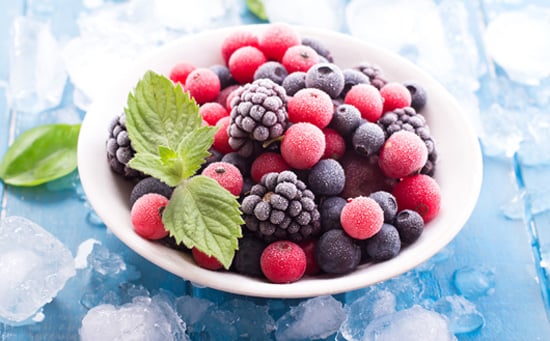About The Buzz: Frozen Fruits & Veggies are Nutritionally Comparable to Fresh?

WHAT THEY’RE SAYING
Most consumers believe that fresh produce is higher in nutritional quality than frozen produce. New research shows that depending upon home storage practices and timing, this perception of fresh produce is not always accurate.1
WHY THIS MATTERS
When people think of nutritious foods, the words raw, unprocessed, fresh, clean and natural come to mind.2 It’s true that fresh fruits and veggies are nutritionally dense and offer an abundance of beneficial vitamins, minerals, fiber and antioxidants. Many people believe that fresh produce offers greater nutritional benefit than other forms of produce, such as frozen, canned, dried or dehydrated varieties.
Overall, many Americans simply are not consuming enough fruits and veggies. A 2013 study showed that 33% of Americans consume less than one serving of fruits and veggies per day.1 To increase consumption of nutritious foods for improved health and wellbeing, it’s important to incorporate cost-effective and sustainable habits into a daily routine. Most Americans report visiting the grocery store about 1.5 times a week, meaning that fruits and veggies need to last about 5-7 days before the next trip to the grocery store.
Despite wanting to eat fresh produce, many people feel that fresh produce is hard to store and can spoil quickly. Some may even avoid buying fresh produce for this reason, noting that “fruits and vegetables go bad fast and I am not going to get them if they go bad”.2 The good news is that purchasing frozen produce can be a nutritious, affordable and easy way to increase fruit and veggie consumption for American families.
WHAT THIS MEANS
New research from the Frozen Food Foundation and the University of Georgia demonstrated that frozen fruits and veggies are comparable nutritionally to fresh produce. In some instances, frozen fruits and veggies offered greater nutritional value than their fresh counterparts.
The study compared broccoli, cauliflower, sweet corn, green beans, green peas, spinach, blueberries and strawberries. The study was carried out over two years and included three storage methods: fresh, fresh-stored (five days of refrigerated storage) and frozen. Vitamin C, beta-carotene (vitamin B) and folate were compared in each produce item for each of the storage methods.
Results demonstrated that overall, there was no significant difference in the nutritional value of fresh versus frozen produce. In most samples, however, fresh-stored produce offered lower nutritional value than fresh or frozen produce. For example, the beta-carotene value of fresh-stored strawberries was found to be 38% lower that of fresh strawberries and 36% below frozen strawberries. In green beans, vitamin C level in green beans was 40% lower than frozen green beans.
OUR ADVICE
Frozen produce is packaged at peak ripeness, unlike fresh produce, which is frequently picked before peak ripeness, packaged, stored, transported and then stored again.2 Frozen produce offers great nutritional value and a much longer shelf life than fresh or fresh-stored produce. The next time you visit the grocery store, definitely stop by the frozen food aisle as you check off items on your shopping list (check out these frozen fruit and veggie recipes!).
5 Ways to Eat More Fruits and Veggies, Save Money and Waste Less!
- Fill half your plate. Aim to fill half your plate with fruits and veggies as you strive to meet your daily recommendation for fruit and veggie intake. As you fill half your plate, aim for color and variety!
- Plan meals. Shopping with intention can help you save money at the grocery store and incorporate more fruits and veggies into your meals and snacks. Plan meals ahead of time to avoid going out to eat or reaching for junk foods when you’re tired or hungry after work, school or a workout on busy weeknights.
- Buy local. Local produce is sold at peak ripeness because this produce is only available in-season and not shipped from across the country or around the world. National Farmers Market Directory
- Freeze for later. If produce is nearing the end of its shelf life, just freeze and enjoy later! Frozen fruit can be used in smoothies or baked goods and veggies can be used in recipes such as soups, stir-fries, casseroles, omelets and crock-pot recipes.
- Store appropriately. Each produce item has an ideal storage method. Make sure you’re maximizing the shelf life of your produce with our fruit and vegetable storage guide.
Video Center: Selection. Storage. Preparation.
How Many Cups Do You Need?
Key Nutrients in Fruits & Vegetables
Fruit & Veggie Database


